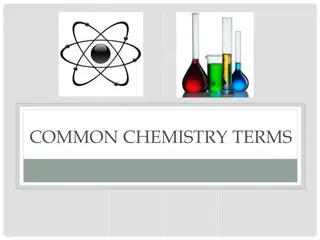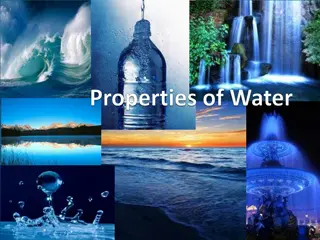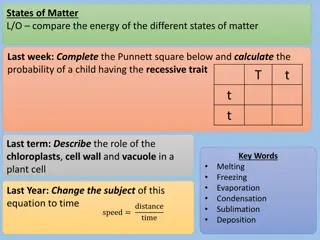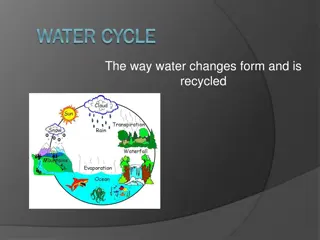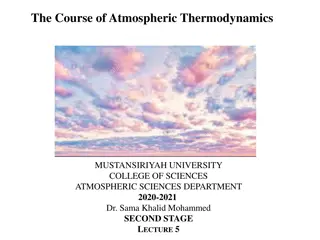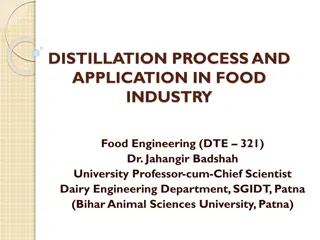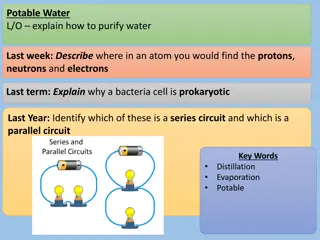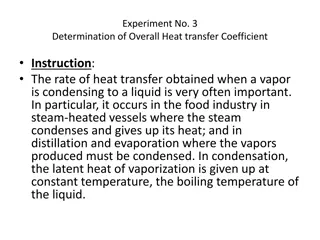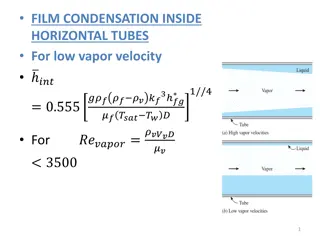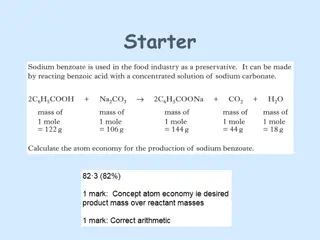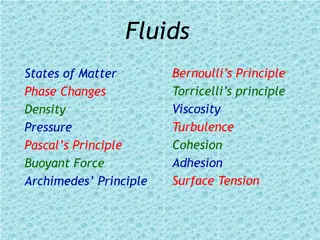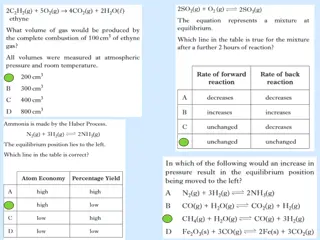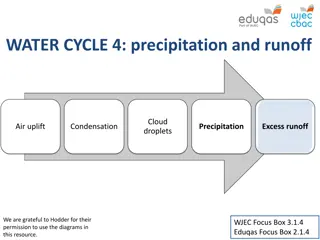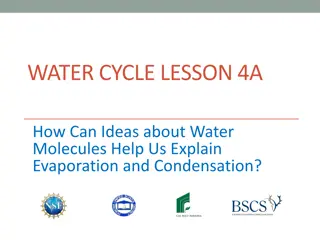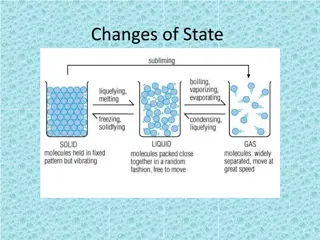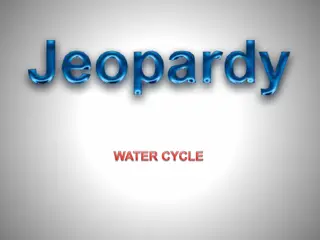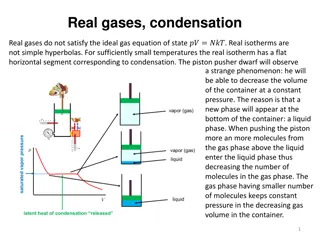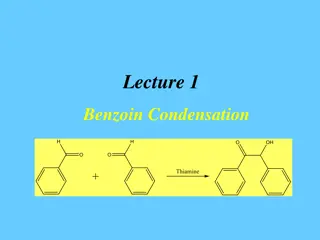Preparation of 2,3-Diphenyl quinoxaline
Quinoxaline, an organic compound, is synthesized through the condensation of benzyl with 1,2-phenylene diamine in this practical organic chemistry experiment at Salahaddin University. Quinoxaline and its derivatives have various applications in dyes, pharmaceuticals, and antibiotics. The process inv
0 views • 9 slides
Understanding Barbiturates: History, Types, and Mechanism of Action
Barbiturates are derivatives of barbituric acid, acting as depressants on the central nervous system by potentiating GABA. First synthesized in 1864, they have a rich history in medicine. Types include Amobarbital, Phenobarbital, and Pentobarbital. The synthesis of barbituric acid involves a condens
0 views • 28 slides
Aldol Condensation Reaction: Preparation of Chalcones
Chalcones are important unsaturated aromatic ketones that serve as biogenetic precursors of flavonoids and isoflavonoids. They have various medicinal and pharmaceutical applications due to their biological activities. Chalcones are easily synthesized compounds with potential therapeutic uses, making
2 views • 13 slides
Ginzburg Landau phenomenological Theory
The Ginzburg-Landau phenomenological theory explains superconductivity and superfluidity as distinct thermodynamic phases. It focuses on phase transitions characterized by singularities in specific heat at the transition temperature. Derived from BCS theory, it quantifies condensation energy, emphas
1 views • 38 slides
Understanding the Water Cycle and Its Importance in Nature
Water is essential for all life on Earth, continuously moving through different physical states in a cycle that has been occurring for over 4 billion years. The Water Cycle involves processes like evaporation, transpiration, condensation, precipitation, and collection, ensuring water is always movin
11 views • 7 slides
The History of the Earth
The Earth, 4.5 billion years old, emerged from a nebula in the Milky Way Galaxy. Gravity led to the condensation of a rotating cloud into the Sun and planets. Over time, lumps collided, forming gas giants, rocky planets, and asteroids. The outer planets attracted hydrogen and helium, while the inner
2 views • 45 slides
Understanding Common Chemistry Terms and Processes
Explore essential chemistry concepts such as matter, pH, acids, bases, mixtures, solutions, vaporization, sublimation, deposition, condensation, and freezing. Learn about the different states of matter, types of mixtures, and physical changes occurring in substances. Enhance your knowledge of chemis
0 views • 39 slides
The Fascinating World of Water: A Vital Element for Life
Water is essential for life on Earth, constituting about 70% of the planet's surface. With its unique chemical makeup (H2O) and properties, water exists in three states and undergoes various physical changes. Fun facts like water's unusual behavior when it freezes add to its allure. Understanding th
1 views • 15 slides
Understanding States of Matter: Energy and Changes
Explore the energy differences between the states of matter, learn about the properties of solids, liquids, and gases, and understand how energy affects state changes through melting, freezing, evaporation, condensation, sublimation, and deposition. Discover the roles of chloroplasts, cell walls, an
0 views • 10 slides
Understanding the Water Cycle and Environmental Conservation
Explore the water cycle processes like evaporation, condensation, precipitation, and accumulation. Learn about watersheds, pollution, resources, leaks, and the importance of conservation. See how fertilizers impact plants and how to conserve natural resources effectively.
0 views • 11 slides
Understanding Atmospheric Thermodynamics in Second Stage Lecture
Explore key concepts in atmospheric thermodynamics, including condensation level, free convection level, and the use of thermodynamic diagrams. Learn about the process of condensation, stability levels in the atmosphere, and the significance of free convection in weather patterns. Discover why therm
0 views • 27 slides
Understanding Precipitation in Meteorology
Precipitation in meteorology is the result of atmospheric water vapor condensing and falling to Earth, a vital element of hydrology. It can occur in liquid or solid forms through processes like evaporation, cooling, condensation, and droplet growth. Different geographic and climate conditions impact
0 views • 17 slides
Benzoin Condensation: A Name Reaction Explained by Dr. Atul Kumar Singh
Benzoin condensation is a classic organic reaction where aromatic aldehydes self-condense to form α-hydroxy ketones. Dr. Atul Kumar Singh, an Assistant Professor of Chemistry, details the mechanism and the specific catalytic properties of cyanide in this reaction. The reaction involves refluxing th
0 views • 6 slides
Explaining the Water Cycle: Nature's Recycling Process
The water cycle, a crucial natural phenomenon, illustrates how water circulates in the environment. Evaporation, condensation, and precipitation are key stages that define this continuous process, sustaining life on Earth.
0 views • 12 slides
Mastering Substance Writing: Key Steps and Techniques
Dr. Somali Saha introduces essential steps for drafting substance, emphasizing comprehension, selection, elimination, crafting, and reproduction. Learn to condense effectively, avoid unnecessary details, and enhance clarity, simplicity, and brevity in writing. Dive into the art of condensation by co
0 views • 7 slides
Importance of Teaching Life Skills for Healthy Child Development
Life skills education plays a crucial role in promoting healthy child and adolescent development by enhancing adaptive behavior, problem-solving abilities, and social skills. It encompasses three core areas: thinking skills, social skills, and emotional skills. Teaching life skills is essential for
4 views • 15 slides
Distillation Process and Applications in Food Industry
Distillation is a separation process used in the food industry to separate components in a mixture based on their volatility. It involves vaporization, condensation, and re-evaporation to achieve separation. Steam distillation is a method where steam is used to reduce boiling temperatures for safe s
1 views • 13 slides
Distillation Process for Purifying Water
Distillation is a method used to purify water by separating it from impurities through evaporation and condensation. It involves heating the water until it evaporates, then cooling the vapor to collect the purified water. This process ensures the removal of harmful substances and microbes, resulting
1 views • 11 slides
Understanding Colloids and Their Importance in Pharmaceuticals
Colloids play a vital role in the pharmaceutical industry as heterogeneous biphasic systems with particle sizes ranging from 1nm to 100nm. They are classified based on aggregation and interaction of phases, with examples like aerosols, foams, emulsions, and more. Colloids can be prepared by condensa
0 views • 23 slides
Determination of Overall Heat Transfer Coefficient in Steam Condenser Experiment
The experiment focuses on determining the overall heat transfer coefficient in a steam condenser, crucial for industries like food processing, distillation, and evaporation. A shell-and-tube heat exchanger setup is used with a steam boiler, measuring the heat transfer rate during vapor condensation.
0 views • 18 slides
Aldol Condensation Reaction for Benzalacetophenone Preparation
Aldol condensation is a key reaction for preparing benzalacetophenone, also known as chalcones. Chalcones are unsaturated aromatic ketones with various medicinal applications, showcasing activities like anti-diabetic, anti-inflammatory, and anti-bacterial effects. The reaction involves combining ben
0 views • 10 slides
Understanding Phase Transformations and Latent Heat Equation in Statistical Mechanics
In this informative piece by Dr. N. Shanmugam, Assistant Professor at DGGA College for Women, Mayiladuthurai, the concept of phase transformations in substances as they change states with temperature variations is explored. The latent heat equation is discussed along with definitions of fusion, vapo
1 views • 22 slides
Understanding Aldehydes and Ketones in Organic Chemistry
Aldehydes and ketones are compounds that contain carbonyl groups (>C=O). Aldehydes have the CO group linked to either two hydrogen atoms or one hydrogen atom and one alkyl or aryl group, while ketones have the CO group linked to two alkyl or aryl groups. The structure of the carbonyl group is charac
0 views • 26 slides
Future Support for Private Landlords in Knowsley: Tenancy Sustainment Forum Highlights
Knowsley Private Landlords Forum in 2011 highlighted the importance of the Tenants Extra Support Scheme (TESS) in sustaining tenancies and preventing homelessness. The event covered topics such as identifying and tackling condensation issues, launching anti-social behavior packs, and understanding t
1 views • 48 slides
Heat Transfer in Condensation Processes: Film and Dropwise Mechanisms
Film condensation inside horizontal tubes for low vapor velocity is explored, highlighting the importance of the condensation number and heat transfer coefficients. Dropwise condensation, characterized by droplets on the surface, is also discussed for its effectiveness in heat transfer. The condensa
1 views • 16 slides
Understanding Pacific Coast Weather Patterns: Rain, Snowfall, and More
Discover the intricate weather patterns of the Pacific Coast, including the role of topographic lifting, condensation, rainshadow effect, and precipitation variations in different regions. Explore the dynamics of rain, snowfall, glaciers, and the movement of glaciers in this visually compelling proj
2 views • 13 slides
Understanding Esters and Their Formation in Chemistry
Learn about esters, their formation through esterification, naming conventions, and how to prepare esters using condensation reactions. Explore the distinct properties of esters, their role in fragrances, flavors, and industrial applications. Get insights into the experimental setup for preparing es
0 views • 17 slides
Understanding Fluids, States of Matter, and Phase Changes
Exploring key concepts in physics including Bernoulli's Principle, viscosity, cohesion, states of matter (solid, liquid, gas, plasma), phase changes (evaporation, condensation, etc.), density, pressure, and more. Discover the properties and behaviors of fluids in relation to gases and liquids, along
1 views • 54 slides
Understanding Fats and Oils: Properties and Formation
Learn about the properties of fats and oils, including their formation through a condensation reaction of glycerol with fatty acids. Explore the role of fats in the diet, different types of natural fats and oils, and the chemical composition of triglycerides. Discover the significance of fatty acids
0 views • 17 slides
Understanding the Water Cycle: Processes and Mechanisms
The water cycle involves various processes such as air uplift, condensation, and precipitation. Cloud formation, rainfall mechanisms like orographic and frontal rain, and the Bergeron-Findeisen process are explained. Activities to understand condensation on windows and cloud precipitation are includ
1 views • 13 slides
Understanding Evaporation and Condensation Through Water Molecules
Exploring the water cycle and states of matter, this lesson delves into how ideas about water molecules aid in explaining evaporation and condensation. Through diagrams, simulations, and real-life scenarios, students learn about the movement and changes of water molecules. By comparing their ideas w
0 views • 12 slides
Understanding Changes of State in Matter
Changes of state in matter refer to the physical transitions that substances undergo, such as melting, freezing, vaporization, and condensation. These transitions involve the addition or removal of energy, impacting the movement of particles and their arrangement. Despite the transformations, the id
0 views • 10 slides
Soft Skills and Life Skills Overview
Soft skills, also known as life skills or people skills, encompass interpersonal and social abilities that enable effective interaction with others. They are acquired through daily life experiences and reflections, in contrast to hard skills gained through formal education. This overview delves into
0 views • 36 slides
Understanding the Water Cycle: Evaporation, Condensation & Precipitation
Explore the water cycle process through evaporation, condensation, and precipitation. Learn how air temperature affects water vapor, leading to the formation of rain and snow. Discover the importance of energy in driving the water cycle and observe examples of these phenomena in nature.
0 views • 53 slides
Organic Chemistry: Aldol Condensation Experiment Overview
Organic chemistry students learn about the Aldol condensation reaction involving ketones and aldehydes. The experiment involves the reaction of acetone with benzaldehyde catalyzed by sodium hydroxide to form a trans, trans-isomer. The reaction is illustrated step by step, from the formation of the e
0 views • 11 slides
Understanding Real Gases and Condensation Phenomenon
Real gases deviate from ideal gas behavior, leading to condensation at low temperatures. The van der Waals equation accounts for real gas properties with empirical constants. The Maxwell construction method predicts the saturated vapor pressure on the isotherm, crucial for understanding liquid-vapor
0 views • 13 slides
Gas Processing: Dew Point Control and Refrigeration Systems
Gas processing involves gathering raw gas from wells, passing it through various units like feed gas receiving, condensate stabilization, gas treating, dew point control, and refrigeration units to control liquid condensation and recover natural gas liquids. Dew point control helps prevent condensat
0 views • 26 slides
Understanding Condensation and Associated Phenomena
Condensation is the process of transforming water vapor into liquid or solid forms based on relative humidity and temperature. Dew point marks the saturation temperature, leading to dew, fog, rain, frost, ice, snow, and hail. Ascending air brings moisture, while descending air causes dryness.
0 views • 5 slides
Understanding Benzoin Condensation and Green Chemistry Aspects
Enzymes play a vital role in catalyzing organic reactions in biological systems. Benzoin condensation can be achieved using cyanide or thiamine, with thiamine offering a greener alternative. The mechanism involves the formation of a Breslow intermediate. Understanding the risks associated with cyani
0 views • 10 slides
Logarithms: Properties, Expansion, Condensation, and Evaluation
Explore the properties of logarithms including expansion, condensation, and evaluation. Learn how to expand and condense logarithmic expressions, evaluate logarithms using different bases, and convert logs into other bases. Practice changing the base to evaluate logarithmic equations.
0 views • 5 slides






